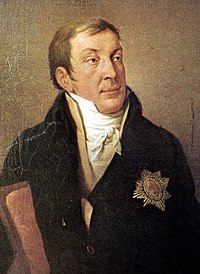
Karl Alois, Prince Lichnowsky of Woschütz; (German: Karl Alois Johann-Nepomuk Vinzenz Leonhard, Fürst Lichnowsky von Woschütz, also known as Carl Alois, Fürst von Lichnowsky-Woschütz; 21 June 1761 – 15 April 1814) was the second Prince Lichnowsky and a chamberlain at the Imperial Austrian court. He is remembered for his patronage of music and his relationships with Wolfgang Amadeus Mozart and Ludwig van Beethoven.
Life
Karl Alois was born as the eldest son of Prince Friedrich Karl Johann Amadeus von Lichnowsky-Werdenberg (1720-1788) and his wife, Countess Maria Karolina von Althann (1741-1800). Although Lichnowsky spent most of his time in Vienna, it was actually in Prussia that he held the title of Prince. His estates were located in Grätz, in the Austrian part of the historic province of Silesia, most of which was conquered by Prussia earlier in the century. The location is today called Hradec nad Moravicí and is within the borders of the Czech Republic.
In his youth (1776 to 1782) he was a law student, studying in Leipzig and in Göttingen. While in Göttingen he met Johann Nikolaus Forkel, who later was to become famous for writing the first biography of J. S. Bach. Lichnowsky at the time began to collect works by Bach in manuscript copies. He also was a musician and a composer. Karl Alois was a Mason and a lodge brother of Mozart; see Mozart and Freemasonry.
Private life
Lichnowsky was married (1788) to Countess Maria Christiane von Thun und Hohenstein (1765-1841), the "beautiful" (according to Otto Erich Deutsch) daughter of Count Franz Josef Anton von Thun und Hohenstein (1734-1801), an Imperial Chamberlain and his wife, Countess Maria Wilhelmine von Thun und Hohenstein, née Countess von Uhlfeldt (1744-1800).
Relationship with Mozart
In 1789 he traveled to Berlin, taking Mozart along with him. For details of the trip, see Mozart's Berlin journey.
He also lent Mozart money, which Mozart was unable to repay. This led the Prince to sue Mozart, and on 9 November 1791, a few weeks before Mozart died, the Lower Austria Court (Landrechte) decided the case in favor of the Prince, ruling that Mozart owed him the sum of 1,435 florins and 32 kreutzer, a substantial amount. The court issued an order to the chamber of the Imperial court (Mozart's employer) to attach half of Mozart's salary of 800 florins per year. The evidence of the lawsuit was uncovered (by Otto Mraz) only in 1991, and hence is not discussed in earlier Mozart biographies.
Relationship with Beethoven
Lichnowsky was one of the most significant aristocratic supporters of Beethoven. In an 1805 letter the composer called him "one of my most loyal friends and promoters of my art."
In 1796, the Prince traveled to Prague, this time taking Beethoven with him. The composer was on his way to Berlin.
In 1800, Lichnowsky gave Beethoven an annual allowance of 600 florins until such time as he found a regular appointment as a musician. The stipend continued until 1806, when a furious quarrel erupted between the two, terminating their friendship: Beethoven, staying at Lichnowsky's country estate, had refused to play for visiting French officers. Later, arriving home in Vienna, Beethoven smashed a bust of the Prince.
Seven of Beethoven's musical compositions, all before 1806, were dedicated to Lichnowsky:
- The three piano trios, Opus 1 (1795)
- The "Nine variations for piano on 'Quant'è più bello' from Giovanni Paisiello's opera La Molinara", for piano solo, WoO 69 (1795)
- The Piano sonata in C minor, Opus 13, "Pathétique" (1798)
- The Piano sonata in A-flat major, Opus 26 (1801)
- The Second Symphony (1802)
Death
He died of a stroke in Vienna on 15 April 1814.
Notes
- Regarding personal names: Fürst is a title, translated as 'Prince', not a first or middle name. The feminine form is Fürstin.
References
- A-Wstm, Taufbuch Tom. C, p. 287
- ^ Clive 2001, 205
- ^ Grove
- Solomon 1995
- Lichnowsky's father-in-law had sympathy for Friedrich Christoph Oetinger's theosophy and for astromechanics: Count Josef Anton von Thun und Hohenstein was hereby a customer of Philipp Matthäus Hahn. He ordered as his uncle Josef Friedrich Wilhelm, Prince of Hohenzollern-Hechingen an astronomic machine constructed by Hahn (former pastor in Onstmettingen near Hechingen) and produced by Philipp Gottfried Schaudt, head teacher in Onstmettingen. Cf. Reinhard Breymayer: Erhard Weigels Schüler Detlev Clüver und sein Einfluss auf Friedrich Christoph Oetinger (1702–1782) In: Katharina Habermann, Klaus-Dieter Herbst (Ed.): Erhard Weigel (1625–1699) und seine Schüler. Universitätsverlag Göttingen, Göttingen 2016, pp. 269–323, here pp. 317–322: Nachweis einer Verbindung zwischen dem mit Mozart und Beethoven vertrauten Franz Joseph Reichsgraf von Thun und Hohenstein, dem Mechaniker Philipp Gottfried Schaudt und dem Pfarrer Philipp Matthäus Hahn. Findet sich eine Spur von Hahns Theologie in Schillers Ode "An die Freude"?
- ^ Deutsch 1965, 339
- Date from Nosow (1997)
- Wiener Zeitung, 20 April 1814, p. 444
Sources
- Clive, Peter (2001) Beethoven and his World: A Biographical Dictionary. Oxford University Press.
- Deutsch, Otto Erich (1965) Mozart: A Documentary Biography. Stanford, CA: Stanford University Press.
- Grove Dictionary of Music and Musicians, article "Lichnowsky". Online edition. Copyright 2007 by Oxford University Press. The article is by Elliott Forbes and William Meredith.
- Nosow, Robert (1997) "Beethoven's popular keyboard publications," Music and Letters 56-76.
- Solomon, Maynard (1995) Mozart: A Life. New York: Harper Collins.
External links
- Prince Lichnowsky page.
- Genealogy: 15 generations of the Lichnowsky Family.